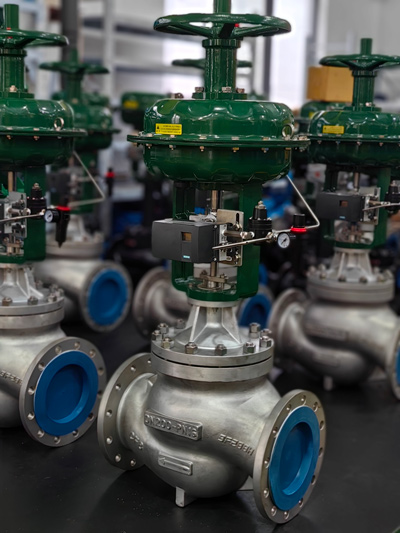Causes and Solutions for Erosion in Control Valves
Erosion is a common challenge in control valves, especially under high-pressure differential conditions with abrasive media. Understanding the causes of erosion and adopting effective solutions can significantly improve valve performance and lifespan.
Why Does Erosion Occur in Control Valves?
Erosion in control valves arises primarily under high-pressure differential conditions, especially when handling media containing suspended particles. At the throttling point, the fluid velocity becomes significantly high—particularly when the valve operates at a small opening.
The kinetic energy of these particles, determined by the product of their mass and the square of their velocity (halved), generates a substantial destructive force. This energy acts on the valve core and seat, leading to material degradation.
The erosion process resembles sandblasting, where abrasive particles carried by a high-speed fluid stream impact the metal surface, cutting and wearing it away.

What Are the Effects of Erosion on Control Valves?
Severe erosion drastically reduces the service life of control valves. In extreme cases, valves may need replacement within mere days, weeks, or months, instead of lasting for years as designed.
| Valve Body Erosion | |
| Causes | Methods |
| 1. Fluid velocity is too high 2. Cavitation and flashing 3. Particles in the fluid | 1. Increase the size of the valve trim to reduce the fluid velocity 2. Change the structure of the valve trim to reduce the flow rate 3. Change the valve body to a streamlined structure to reduce the impact of the fluid 4. Increase the hardness of the valve body material 5. Use stainless steel material for welding repairs 6. Avoid cavitation and use a valve with low pressure recovery |
| Valve Trim Erosion | |
| Causes | Methods |
| 1. Fluid velocity is too high 2. Cavitation and flashing 3. Particles in the fluid | 1. Increase the size of the valve or valve trim to reduce fluid velocity 2. Use streamlined structure to avoid impact 3. Use hard material valve trim 5. Change the valve trim structure to reduce flow rate 4. Avoid cavitation and use valve or valve trim |

Frequently Asked Questions
Q: Is chrome plating on the ball valve suitable for drinking water?
A: Chrome plating is just a process added to the surface of the valve body. The inside of the ball valve remains the same after chrome plating, so it can still be used for drinking water.
Q:What is the leakage level of the angle seat valve?
A: Zero leakage
Q:What are the advantages of PTFE material?
A: It has good acid and alkali resistance and corrosion resistance, but its hardness is low, suitable for low pressure and pressure reduction systems.
Q:What are the advantages of PPL material?
A: It has good acid and alkali resistance and corrosion resistance, high hardness, but expensive.
Q:What are the advantages of PVDF material?
A: It has strong acid and alkali resistance and corrosion resistance, high hardness, but the price is relatively high.